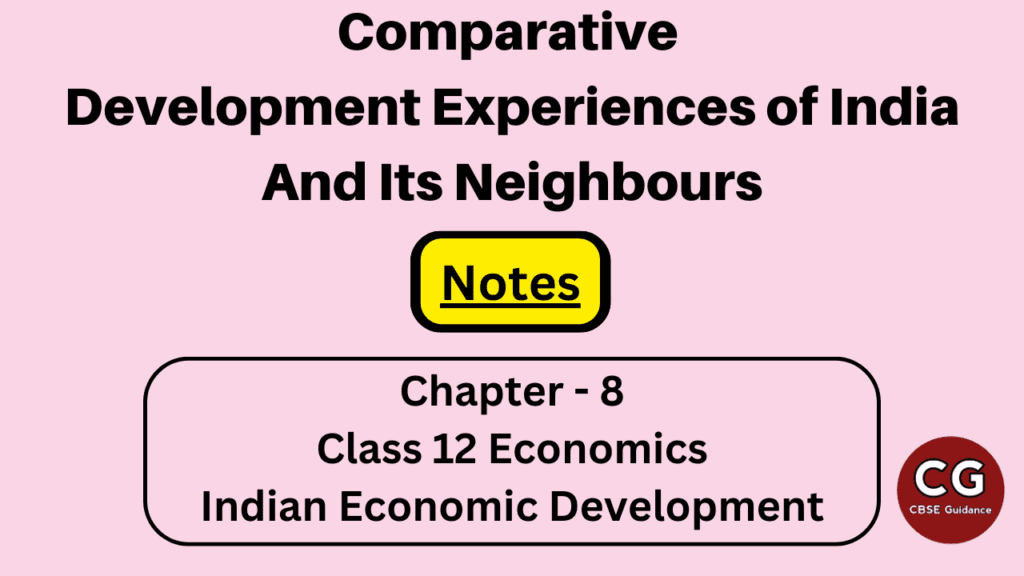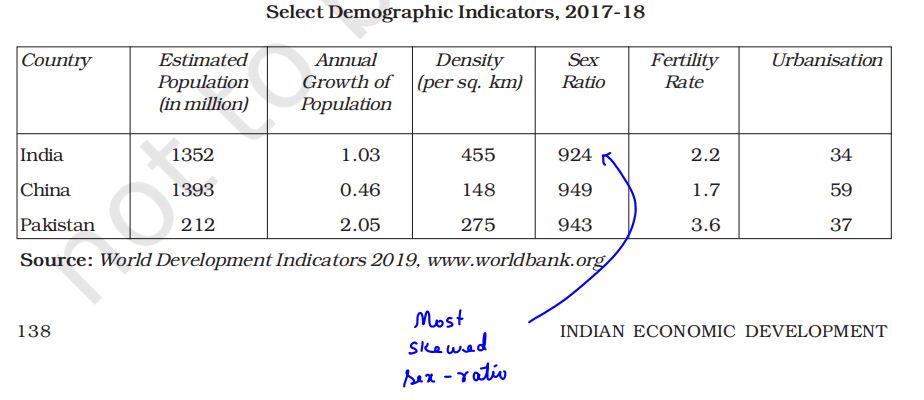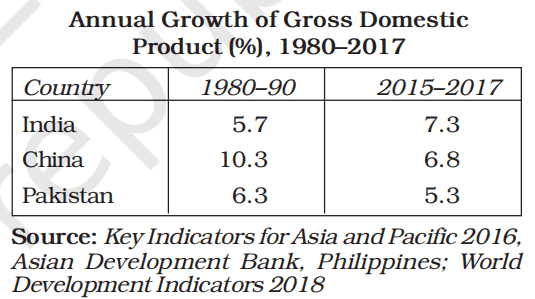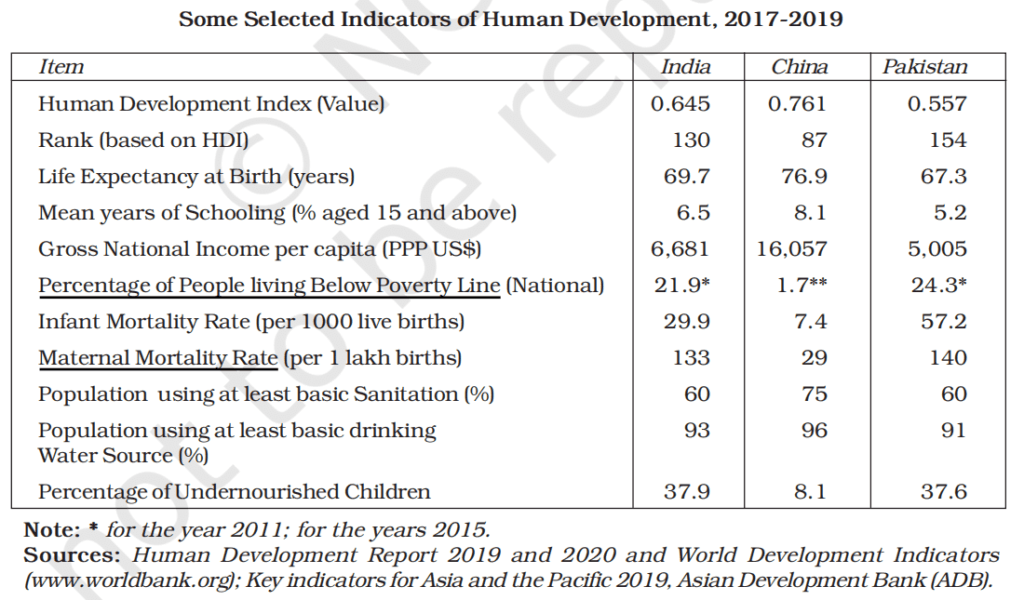Welcome to an exploration into the comprehensive notes on the comparative experiences of India and its neighbors: Pakistan and China. For the students of Class 12 Economics gearing up for the 2024-25 board exams, this journey into Chapter 8 – Indian Economic Development is indispensable.
The Class 12 syllabus for the academic year 2024-25 mandates a thorough grasp of the comparative development experiences of India, Pakistan, and China.
To gain a deeper understanding, we'll compare India's development to that of its neighbors, Pakistan and China. By analyzing their policies, societies, and histories, we can identify India's strengths and weaknesses.

| Board | CBSE and State Boards |
| Class | 12 |
| Subject | Economics |
| Book Name | Indian Economic Development (IED) |
| Chapter No. | 8 |
| Chapter Name | Comparative Development Experiences of India and its Neighbours |
| Type | Notes |
| Session | 2024-25 |
“Don't be afraid to fail. Not failure, but low aim, is the greatest crime.”
— Vince Lombardi
Comparative Development Experiences of India and its Neighbours Class 12 Notes
Table of Contents
Development Path - A Snapshot View
All three countries had started planning their development strategies in similar ways.
- India announced its first Five Year Plan for 1951–56,
- Pakistan announced its first five-year plan, now called the Medium Term Development Plan, in 1956.
- China announced its First Five Year Plan in 1953.
- India and Pakistan adopted similar strategies, such as creating a large public sector and raising public expenditure on social development.
Till the 1980s, all three countries had similar growth rates and per capita incomes.
China
Great Leap Forward (GLF) campaign
- Initiated in 1958 aimed at industrializing the country on a massive scale.
- People were encouraged to set up industries in their backyards.
- In rural areas, communes were started. Under the Commune system, people collectively cultivated lands.
- GLF campaign met with many problems:
- A severe drought caused havoc in China killing about 30 million people.
- When Russia had conflicts with China, it withdrew its professionals who had earlier been sent to China to help in the industrialization process.
In 1965, Mao introduced the Great Proletarian Cultural Revolution (1966–76) under which students and professionals were sent to work and learn from the countryside.
Reforms in China
- Reforms were introduced in China in 1978.
- In the initial phase, reforms were initiated in the agriculture, foreign trade, and investment sectors. In agriculture commune lands were divided into small plots, which were allocated (for use not ownership) to individual households.
- In the later phase, reforms were initiated in the industrial sector. Private sector firms were allowed to produce goods. At this stage, State Owned Enterprises—SOEs, were made to face competition.
- The reform process also involved dual pricing. This means fixing the prices in two ways; farmers and industrial units were required to buy and sell fixed quantities of inputs and outputs on the basis of prices fixed by the government and the rest were purchased and sold at market prices.
- In order to attract foreign investors, special economic zones were set up.
Pakistan
- Pakistan follows the mixed economy model.
- In the late 1950s and 1960s, Pakistan introduced a variety of regulated policy frameworks (for import substitution-based industrialization).
- The introduction of the Green Revolution led to mechanization and an increase in public investment in infrastructure in select areas
- In the late 1970s and 1980s, the major thrust areas were denationalization and encouragement of the private sector.
- During this period, Pakistan also received financial support from Western nations and remittances from the continuously increasing outflow of emigrants to the Middle East.
- In 1988, reforms were initiated in Pakistan
Note: Reforms were introduced in 1978 in China, in 1988 in Pakistan, and in 1991 in India.
Demographic Indicators

- The population of Pakistan is very small and accounts for roughly one-tenth of China or India.
- Though China is the largest nation and geographically occupies the largest area among the three nations, its density is the lowest.
- The population growth is the highest in Pakistan, followed by India and China.
- The one-child norm was introduced in China in the late 1970s.
- Implications of One Child Policy Introduced in China:
- It is the major reason for low population growth.
- This led to a decline in the sex ratio.
- After a few decades, in China, there will be more elderly people in proportion to young people.
- India has the most skewed sex ratio.
- The fertility rate is low in China and very high in Pakistan.
- Urbanization is high in China with India having 34% of its people living in urban areas.
Gross Domestic Product and Sectors

- When many developed countries were finding it difficult to maintain a growth rate of even 5%, China was able to maintain near double-digit growth during the 1980s.
- In the 1980s, Pakistan was ahead of India; China was having double-digit growth and India was at the bottom.
- In 2015–17, there was a decline in Pakistan and China’s growth rates, whereas, India met with a moderate increase in growth rates.
- Some scholars hold the reform processes introduced in Pakistan and political instability over a long period as reasons behind the declining growth rate in Pakistan.
Sectoral Share of Employment and GVA

- Until the 1980s, more than 80% of the people in China were dependent on farming as their sole source of livelihood.
- In 2018-19, with 26% of its workforce engaged in agriculture, its contribution to the GVA in China was 7%
- In both India and Pakistan, the contribution of agriculture to GVA was 16 and 24 percent, respectively, but the proportion of the workforce that works in this sector is higher in India.
- In the normal course of development, countries first shift their employment and output from agriculture to Industry and then to services. This is happening in China.
- In all three countries, the service sector is emerging as a major player in development. It contributes more to GVA and, at the same time, emerges as a prospective employer.
- In the last five decades, the growth of the agriculture sector, which employs the largest proportion of the workforce in all three countries, has declined.
- China’s growth is contributed by the manufacturing and service sectors, and India’s growth by the service sector.
Indicators of Human Development

China is moving ahead of India and Pakistan. This is true for many indicators —
- income indicator such as GDP per capita
- proportion of the population below the poverty line
- health indicators such as mortality rates
- access to sanitation
- literacy
- life expectancy
- malnourishment.
Liberty Indicators: Liberty indicators are measures or criteria used to evaluate the degree of freedom and individual rights within a society.
Here are some liberty indicators:
- Democratic Participation in Decision-Making
- Constitutional Protection of Citizens' Rights
- Independence of the Judiciary
- Rule of Law
Development Strategies - An Appraisal
China
- China did not have any compulsion to introduce reforms as dictated by the World Bank and International Monetary Fund to India and Pakistan.
- Before the introduction of reforms, there had already been a massive extension of basic health services in rural areas.
- Through the commune system, there was a more equitable distribution of food grains.
- Experts also point out that each reform measure was first implemented at a smaller level and then extended on a massive scale.
Pakistan
Scholars argue that in Pakistan the reform process led to the worsening of all the economic indicators.
The reasons for the slow-down of growth and re-emergence of poverty in Pakistan’s economy, are:
- political instability,
- over-dependence on remittances and foreign aid
- volatile performance of the agriculture sector
| Also Read: Class 12 Important Questions Class 12 Notes |
Hope you liked these Notes on Class 12 Economics Indian Economic Development Chapter 8 Comparative Development Experiences of India and its Neighbours. Please share this with your friends and do comment if you have any doubts/suggestions to share.
Nice notes